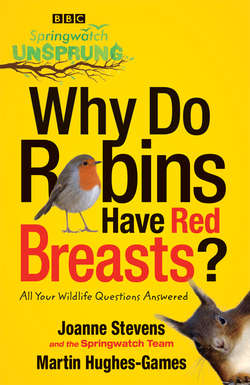Читать книгу Springwatch Unsprung: Why Do Robins Have Red Breasts? - Jo Stevens - Страница 28
Old Sparrow, New Tricks
ОглавлениеHow long do sparrows live? A few years ago, a male sparrow visiting the seed feeder in our yard was seen flying to the top of our wall with seeds for his fledglings for a few days, then the next day, when they were able to fly down to the ground, he perched at the feeder and dropped seed to them. He then seemed to get fed up with this process because it was too slow, so took to flying at the feeder and crashing into it with both feet up to shake a shower of seed down. The next year, we saw the same behaviour but then not for the next couple of years. So when it reappeared this year we wondered if it could be the same bird, or one of his descendants. Any ideas? Linda
Linda doesn’t mention whether the sparrow was a tree or house sparrow but either way it’s likely that the clever parenting she witnessed was performed by two different birds. The oldest recorded house sparrow lived for twelve years but their average lifespan is about three years. A tree sparrow is known to have lived for over ten years but typically they only survive for a couple of years. So, while it’s feasible that the original sparrow returned, it is unlikely. Instead, the new feeder-bashing sparrow could be evidence of an interesting phenomenon called cultural learning.
Cultural learning occurs when a new behaviour, like a novel feeding strategy, is transmitted from one individual to another within a population or from one generation to the next. This is particularly important in social birds such as house sparrows and starlings. Recent research suggests that birds living in large groups, such as sparrows, are better at solving problems because the individuals all have different experiences and skills to draw upon. We’ll never know whether Sue’s feeder-bashing sparrows learned the trick from the original sparrow or worked it out independently. However, if the behaviour had been passed on it doesn’t imply that the original feeder-bashing sparrow intentionally taught the new skill to others; they probably just imitated him.
The most well-known instance of cultural learning is the intriguing case of the milk thieves. In the good old days, when milk was delivered to the doorstep by a friendly milkman whistling a merry tune, an inquisitive blue tit or great tit discovered that those glass bottles contained fat-rich cream. Originally, milk was delivered in open bottles that birds could easily drink from, but later, when milk bottles were covered with silver foil, blue tits and great tits soon learned to peck through the foil to steal the creamy goodness underneath. The pecking of milk bottle tops rapidly became widespread. It took 25 years for the habit to grow from one observation to being seen in over 400 different locations. Whether each bird worked out how to do this independently or just watched and copied others is open to debate. The behaviour did not spread out in a wave from the original location but popped up sporadically, suggesting that it arose on several occasions. Blue tits and great tits often peel off bark looking for insects and grubs. They are naturally curious and have relatively large brains so it would not have been a huge step to try peeling off milk bottle tops. Of course, there’s no reason why birds would not have copied the behaviour from each other within each location, so it’s likely that a combination of inquisitive individuals and social learning was responsible for the stolen milk. Now that fewer people have milk delivered, this behaviour is rarely seen.
